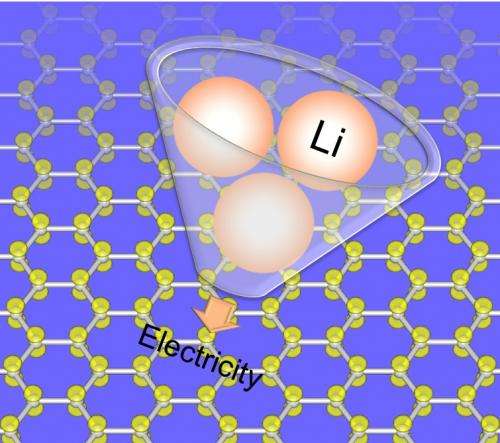Scientists characterize carbon for batteries

Lithium-ion batteries could benefit from a theoretical model created at Rice University and Lawrence Livermore National Laboratory that predicts how carbon components will perform.
The model is based on intrinsic characteristics of materials used as battery electrodes. These include limitations on quantum capacitance (the ability of the material to absorb charge) and the material's absolute Fermi level, which determines how many lithium ions may bond to the electrodes.
Subtle changes in the structure, chemistry and shape of an electrode will alter how strongly lithium ions bond to it and affect a battery's capacity, voltage and energy density. In fact, the researchers found what they called a "universal" linear relationship between the lithium binding energy and the "states-filling work" (determined by the quantum capacitance and the Fermi level of the material) that should allow scientists to fine-tune electrodes.
The research appears in the journal Physical Review Letters. Lawrence Livermore scientist Brandon Wood and Rice theoretical physicist Boris Yakobson led the study.
Fine-tuning becomes critically important as materials scientists test more 2-D materials like graphene and nanotubes for use as electrodes. The materials offer vast surface area for ions to bind to in a compact package, Yakobson said.
"This work emphasizes the role of quantum capacitance," he said. "Capacitance in a battery is usually defined by the configuration of your electrodes; people think about this as the distance between the plates.
"But if the plates become very close and the electrodes and electrolyte are tight, then quantum capacitance becomes the limiting parameter."
"The Fermi level of the electrode material is also important," said Rice graduate student Yuanyue Liu, the paper's lead author. "The lower it is, the stronger lithium will bind."
Liu and Lawrence Livermore staff scientist Morris Wang needed a "descriptor," a characteristic that would capture the essential physics of interactions between lithium and a variety of carbon materials, including pristine, defective and strained graphene, planar carbon clusters, nanotubes, carbon edges and multilayer stacks.
"That descriptor turned out to be the 'states-filling work' – the work required to fill previously unoccupied electronic states within the electrode," Liu said.
"Generally speaking, a descriptor is an intermediate property or parameter that doesn't give you what you really want to know, but correlates well with the material's final performance," Yakobson said.
"The descriptor connects to properties that may be quite complex," he said. "For instance, you can judge people's physical strength by how tall they are or by weight. That's easy to measure. It doesn't exactly tell you how strong the person will be, but it gives you some idea."
Based on the descriptor, the researchers were able to evaluate various carbon materials. Specifically, they found materials like defective or curved graphene were good candidates for anodes, as their energy profiles allowed more lithium ions to bind. Ultimately, their work suggested a set of binding guidelines for carbon anodes.
"These allow us to quickly evaluate material performance without doing electrochemical tests or expensive computations," Liu said.
Yakobson noted the work is in line with the Materials Genome Initiative (MGI), which aims to double the speed and reduce the cost of developing advanced materials by providing these kinds of tools. Earlier this year, Rice's George R. Brown School of Engineering hosted a workshop on the MGI initiative, one of four held around the country.
More information: Assessing Carbon-Based Anodes for Lithium-Ion Batteries: A Universal Description of Charge-Transfer Binding, Phys. Rev. Lett. 113, 028304 , journals.aps.org/prl/abstract/ … ysRevLett.113.028304
Journal information: Physical Review Letters
Provided by Rice University


















